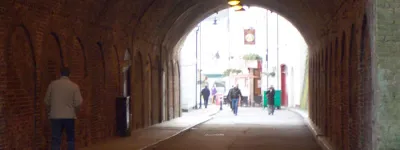The father of all four-way interchanges, cloverleaf junctions started appearing in Germany and the USA during the 1920s, connecting the world's earliest motorways. They're widespread across the world - but in the UK, there are only two of them.
Limited-access roads
Surface roads
Vertical levels
Bridges required
Access between roads
Number in UK
First built in UK
In this country, cloverleaf junctions were pencilled into early plans for the motorway network from the 1930s onwards, and there were firm proposals for their use on the Preston Bypass (later the M6) when detailed designs were first produced in the 1940s. The original standards for motorway direction signs even included diagrams specifically for use on this type of junction.
But the UK was late to the motorway party, and our earliest limited-access roads had no need for free-flowing interchanges. It wasn't until the mid-1960s that we first had a situation where two motorways needed to cross, and while a cloverleaf was considered, by that time more sophisticated junction designs had evolved. The first four-way motorway junction was, in the end, a Four Level Stack at Almondsbury near Bristol. In fact, no cloverleaf junction was ever built on the UK motorway network, and only three were built at all. Today two of them survive.
Though they exist in great numbers across the world, they are no longer considered suitable for major interchanges in most places. In the USA, Germany, the Netherlands and elsewhere, busy cloverleaf junctions are now replaced or modified. They are now preferred for interchanges between motorways and main roads, and their use solely between motorways is discouraged.
The world's first cloverleaf is still with us. The Schkeuditzer Kreuz near Leipzig in Germany opened in 1936 and is still there, though it has been modified several times.

Why build one?
The cloverleaf isn't well suited to the UK. By the time we had a requirement for a four-way free-flowing junction, there was competition from other designs, and they all suited us better. We need compact junctions with high capacity, to match our busy roads and expensive land prices; the cloverleaf, on the other hand, takes up a lot of room and has an inbuilt flaw: the loops cause traffic to begin entering and merging before other vehicles have exited. That causes conflict, called weaving, and limits capacity.
It's possible to fix the weaving issue by building parallel collector-distributor lanes through the junction, so that the weaving happens off the main motorway and to the side, and that is how the majority of busy cloverleaf junctions now operate worldwide. But it doesn't fix the problem that this is a junction designed for a world in which land is cheap and bridges are expensive. The opposite is true in the UK: we'd rather build structures if it means we can take up less space.
That is why the only three cloverleaf junctions that were ever built in the UK are in New Towns: two in Livingston, near Edinburgh, and one in Redditch, south of Birmingham (there's a blog post about that one). They are in places where land use was not an issue, as a vast area had been handed to a Development Corporation, and where a huge road network was planned amid green space and landscaping. In that situation, land was no issue and experimentation was everywhere. But everywhere else, the cloverleaf has never turned out to be the answer.
What we have built on the motorway network, of course, is the Partially Unrolled Cloverleaf.
Advantages
- Low construction cost as only one bridge is required.
- Both roads are fully grade separated.
- Navigational errors can be corrected by circling around the loops.
- Can be upgraded by realigning sliproads without great difficulty or expense.
Disadvantages
- Inefficient use of space, as redundant patches of land are left within the loops.
- Disorienting for right-turning traffic.
- Loops can be prone to accidents if they are too small.
- Capacity may limited by "weaving" — conflicts between traffic entering and exiting the loops in the middle of the junction.
Variations
While there aren't many true cloverleaf junctions in the UK, you can find several close relatives. In almost all these cases, they are either missing some sliproads or are broken up with a roundabout. One of the closest near misses lies in Plymouth, at the junction of the A386 and B3413 in Crownhill, is only disqualified for a roundabout that breaks up a pair of sliproads in one corner. The A3/A238 junction near New Malden on the Kingston Bypass is only missing one of its loops.
The closest thing to a cloverleaf on a motorway might be A1(M) J38 Red House Interchange, at the northern end of the Doncaster Bypass, which is missing three sliproads and not a lot else.
The decline of the cloverleaf
Two of the UK's three cloverleaf junctions were in Livingston. One of them, at the junction of the A889 and an unclassified road, had four of its sliproads removed in about 2005, and a pair of roundabouts were added. That leaves us with two cloverleaf junctions — and there are suggestions that Livingston's other cloverleaf, the A889/A705 junction just to the south, is in the firing line as soon as funding is available. Now why on earth would you want to tear up two perfectly good free-flowing junctions?
The latest indication seems to be that funding has not been found for removing the second Livingston cloverleaf, so it looks like it's safe for now.
With thanks to Tim Kreutzer, Phil Reynolds, Michael Davidson, Dave Ryan and George Carty for information on this page.

